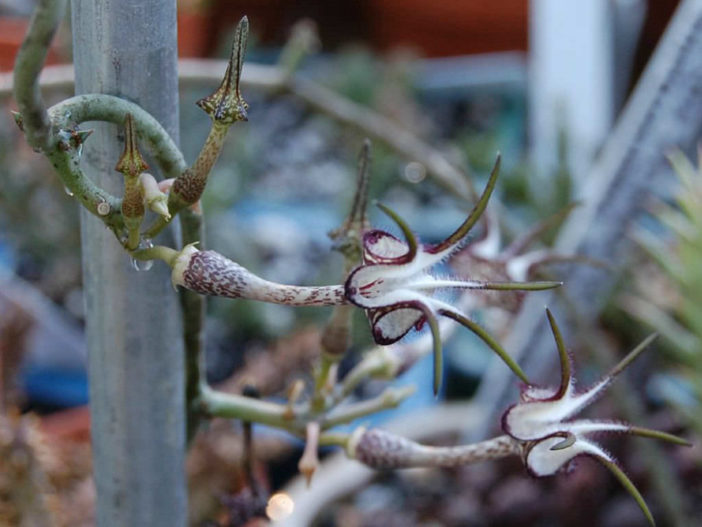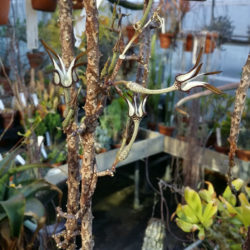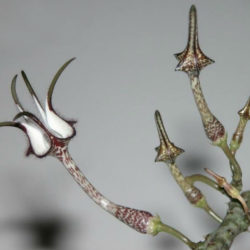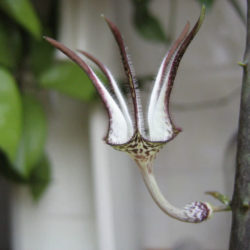Scientific Name
Ceropegia stapeliiformis Haw.
Common Name(s)
Serpent Ceropegia, Slangkambro, Snake Creeper
Synonym(s)
Ceropegia stapeliiformis subsp. stapeliiformis
Scientific Classification
Family: Apocynaceae
Subfamily: Asclepiadoideae
Tribe: Ceropegieae
Genus: Ceropegia
Origin
Ceropegia stapeliiformis is native to South Africa and Eswatini. Ceropegia stapeliiformis subsp. stapeliiformis occurs in areas of karroid scrub from Uitenhage and Willowmore to Graaff Reinet and King William's Town in the Eastern Cape province.
Description
Ceropegia stapeliiformis is a succulent plant with decumbent or trailing, cylindrical, tuberculate stems with smooth, dull green branches mottled and often tinged with purple. The stems are fleshy and reach up to 0.6 inches (1.5 cm) in diameter, rooting in contact with soil. The branches are constricted at the junction, tapering and sometimes climbing towards inflorescences. The rudimentary leaves arise from a tubercled base and soon fall off the stems.
The flowers appear in spring and early summer. The corolla is up to 2.8 inches (7 cm) long, pale greenish-white, spotted with maroon, divided nearly halfway, with an egg-shaped base expanded into a funnel-shaped mouth and five usually spreading recurved lobes. It is white with violet-purple, greenish-yellow, or purple-brown margins and tips and covered with short hairs on the lower part of the inner face. The fruits are grey-green, broadly fusiform, tuberculate follicles that can reach up to 4 inches (10 cm) in length.

Hardiness
USDA hardiness zones 10a to 11b: from 30 °F (−1.1 °C) to 50 °F (+10 °C).
How to Grow and Care
A gritty compost is suitable, and clay pots help with drainage, especially for the species with white thickened roots, which are the most susceptible to rotting, and for species forming large tubers. Ceropegias appreciate water and a little fertilizer during warm weather, although some care with watering is required for the more difficult species. The vine-like species can suffer from prolonged drought.
Typically, many of these species grow and climb naturally among bushes, which provide shade and humidity to the base, while the vegetative growth is in the light. Where tubers occur, they are best planted on the compost surface, and the vegetative growth is allowed to twine around supports or trail down from a hanging pot. The latter growth mode has the advantage of not using valuable bench space. Small tubers formed at joints in the thin stems of some species can be used for propagation. If the tuber rots or dries out, don't panic. If some of the top growth is still in reasonable condition, it may be possible to save the plant by re-rooting stems in damp gravel.
See more at How to Grow and Care for Ceropegia.
Links
- Back to genus Ceropegia
- Succupedia: Browse succulents by Scientific Name, Common Name, Genus, Family, USDA Hardiness Zone, Origin, or cacti by Genus
Photo Gallery
Click on a photo to see a larger version.


